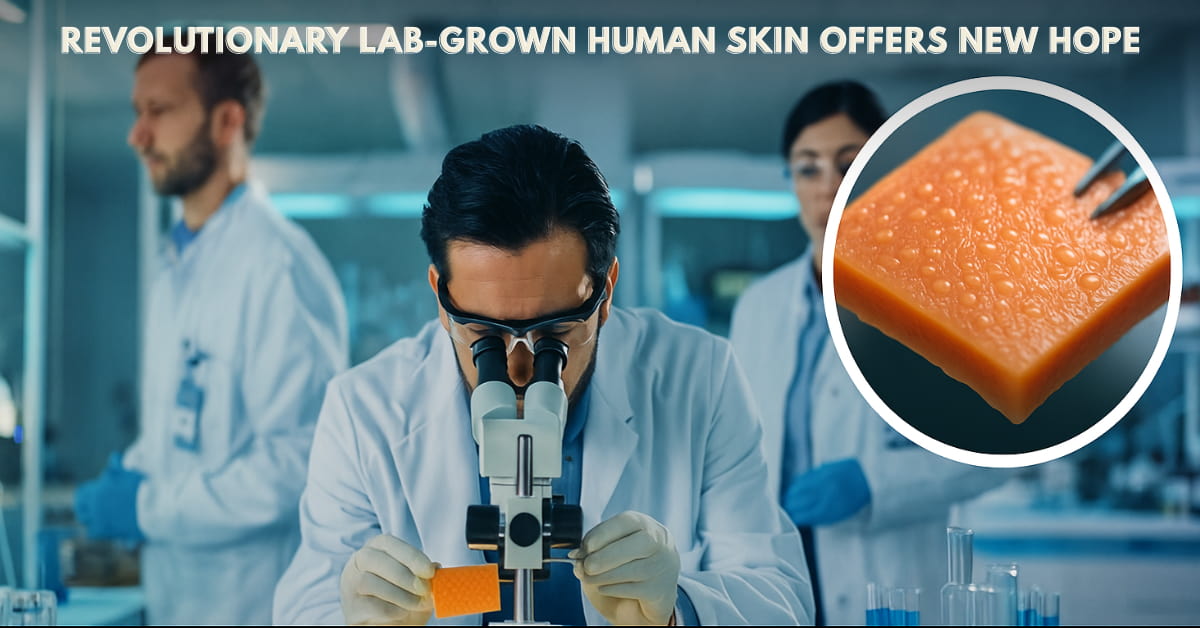Revolutionary Lab-Grown Human Skin Offers New Hope

Introduction
Researchers are now able to generate lab-grown human skin that goes beyond simple epidermal sheets. These skin organoids include multiple skin layers, functional appendages such as hair follicles and sweat glands, and even neural and vascular networks. This breakthrough holds promise for serious burn treatment, chronic wound repair, personalized medicine, and drug testing.
The field is complex, with promising results but significant hurdles. Let’s unpack the science, materials, experiments, and future potential.
Table of Contents
What Are Skin Organoids?
Definition and distinction
- A skin organoid is a three-dimensional (3D) tissue construct grown in vitro from stem cells or primary cells that self-organize into structures mimicking native skin architecture. PMC+2BioMed Central+2
- It includes at minimum epidermis and dermis. Advanced models incorporate appendages (hair follicles, sebaceous glands, eccrine sweat glands), nerves, blood vessels. BioMed Central+1
- These differ from classical skin equivalents (flat sheets) because they self-organize and form more realistic tissue complexity.
Why they matter
- Traditional skin grafts and synthetic substitutes provide coverage but often lack functional elements like sweat glands and nerves.
- Skin organoids aim to restore not just appearance, but actual physiological function – temperature regulation, sensation, lipid production, immune response.
- They create better human-relevant models for disease study and drug screening.
Key Scientific Milestones
Early foundational work
- In 2019, researchers created sweat gland organoids from adult mouse sweat gland cells embedded in 3D matrix. These organoids could regenerate sweat-gland-like structures when transplanted into mice. Nature
- In 2021 and earlier, skin organoids derived from human induced pluripotent stem cells (iPSCs) included hair follicles and sebaceous glands. PMC+1
Recent breakthrough: hair, sweat glands, vessels
- In March 2024, the University of Queensland (UQ) team announced lab-grown human skin organoids from iPSCs that developed hair follicles, sebaceous glands, sweat glands, neurons and microvasculature. News
- Publications in 2023 and 2025 detail advances in bioengineered skin organoids with vascularization and improved architecture. BioMed Central+1
Current status
- These models have been demonstrated in vitro and in animal grafts; human clinical use remains on the horizon.
- Functional tests (e.g., sweat gland response) are ongoing.
- Regulatory, manufacturing, scalability issues still to resolve.
How Lab-Grown Human Skin Works: Cellular & Engineering Details
Cell sources
- Human pluripotent stem cells (hPSCs) or induced pluripotent stem cells (iPSCs) derived from adult cells. News+1
- Sometimes adult primary dermal/epidermal cells, or sweat-gland progenitors, are used. BioMed Central+1
Differentiation and culture process
- Aggregation / Embryoid body formation – Cells are induced to form 3D spheres.
- Signal modulation – Researchers apply growth factors / pathway modulators (WNT, BMP, FGF, TGF-β) to direct differentiation into skin lineages. BioMed Central+1
- 3D culture environment / scaffold – Cells are grown in hydrogels or matrices; some under air-liquid interface to promote stratification and appendage development. PMC
- Maturation – Over weeks to months, the organoid develops layered epidermis, dermis, hair follicle structures, sweat glands, nerves, microvessels.
- Functional validation – Histology, immunostaining, transcriptomics (single cell RNA-seq), and sometimes in vivo grafting to test integration. News+1
Engineering and material components
- Hydrogels / matrices: Matrigel (animal-derived) has been common; newer defined synthetic scaffolds/hydrogels are being developed for better reproducibility and clinical translation. BioMed Central
- Bioprinting / microfluidics: Some groups use 3D bioprinting to structure tissue, microfluidic chips for perfusion. BioMed Central
- Vascularization strategies: Incorporating endothelial cells, promoting host vessel ingrowth in in vivo grafts, designing channels to simulate capillaries.
- Characterization tools: Imaging (confocal, live imaging), gene/protein marker assays, functional tests (e.g., sweat secretion, nerve response).
Sweat Gland Integration
- Sweat glands (eccrine type) are critical for thermoregulation and fluid excretion. Fully regenerating them has been a major challenge. BioMed Central+1
- Organoid methods: isolate progenitors, embed in 3D environment, expand and differentiate into sweat gland lineage, then transplant. Nature
- Functional markers: CK18/CK19 (cytokeratins), aquaporin AQP5, α-ATPase, etc. In transplantation, these organoids contribute to sweat gland repair. Nature
Achievements & Evidence Summary
In vitro achievements
- Production of skin organoids that mimic human skin architecture grossly, including stratified epidermis + dermis + appendages. (Hong et al. 2023) BioMed Central
- Creation of sweat gland organoids with functional markers from mice and human cells. (Diao et al. 2019) Nature
- UQ’s human iPSC-derived skin organoids: hair follicles, sebaceous and sweat glands, neurons, microvessels. (2024) News
In vivo / graft evidence
- Sweat gland organoid cells transplanted into mouse wound models, showed improved healing and signs of gland regeneration. Nature+1
- Grafts of organoid skin onto immunodeficient animals show hair growth and integration of appendages in some experiments. PMC+1
Implications for burn and wound care
- The possibility to move beyond simple skin coverage toward living skin grafts that restore function (sweat, sensation, hair) could drastically improve outcomes for burn victims.
- The technology advances stem cell skin grafts from concept toward reality.
How Life Could Change for Patients
For burn victims and chronic wounds
- Improved thermoregulation: If grafted skin contains functional sweat glands, patients regain better temperature control, less overheating, fewer complications.
- Better aesthetic and functional recovery: Grafts with hair follicles, sebaceous glands, nerves can yield more ‘normal’ skin – less scarring, improved sensation, less lifelong dependency on ointments.
- Reduced infection risk and better barrier: More complete skin architecture means more resilient to environmental insults.
- Personalized grafts: Using patient-specific iPSCs may reduce rejection risk and tailor grafts to individual.
- Faster rehabilitation and improved quality of life: Better skin means fewer follow-up surgeries, less pain, more mobility.
Beyond direct patient care
- Better drug testing: Lab-grown human skin with appendages offers more accurate human-relevant models (reducing animal use).
- Disease modelling: Genetic skin disorders (e.g., epidermolysis bullosa) can be modelled and corrected in vitro.
- Cosmetic and transplantation advances: Hair generation, sweat gland restoration, scar prevention.
- Cost savings: Over time, more advanced grafts may reduce long-term care cost for severe wounds.
Challenges & Limitations
Scale and coverage
- Organ-scale production remains difficult. Covering large burn areas (thousands of square centimeters) with functional grafts is not yet feasible.
- Controlling uniformity, thickness, integration across large surfaces remains a hurdle.
Manufacturing, cost, and regulation
- Producing iPSC-derived skin grafts at GMP (good manufacturing practice) for humans is expensive and complex.
- Regulatory approval for complex grafts with multiple cell types and appendages is uncharted. Long safety follow-up needed.
- Cost may limit access initially to wealthy health systems.
Integration and long-term functionality
- Vascular and neural integration into host tissue is essential for survival and function of grafts. Full functional sweat gland responses in humans remain unproven.
- Longevity, durability, risk of rejection, tumorigenicity of residual pluripotent cells must be rigorously tested.
- Immune compatibility: Even if patient-derived iPSCs are used, epigenetic differences, cell culture artefacts can trigger immune responses.
Standardization and reproducibility
- Variability between cell lines, batches, scaffolds. The field still needs robust standardized protocols. PMC+1
- Quality control metrics: How to define “functional sweat gland” or “fully functioning hair follicle” in a reproducible way?
Clinical Translation & Timeline
Preclinical stage
- Animal graft studies with skin organoids showing proof of concept.
- Optimization of scaffolds, vascularization, maturation protocols.
- Safety studies including tumor risk, immune response, integration.
Early human trials (estimated)
- Small safety trials with segmented grafts on humans (e.g., partial coverage, less severe wounds).
- Monitoring of graft take, function (sweat secretion, hair growth), complications.
- Manufacturing workflows developed under GMP.
Widespread clinical use (long-term)
- Large burns and full body coverage using living skin grafts may still be 5–10+ years away.
- Cost reductions, simplified protocols, off-the-shelf options may accelerate adoption.
Key stakeholders
- Academia (stem cell labs, biofabrication institutes)
- Clinicians (plastic surgery, dermatology, burn units)
- Industry (biotechnology firms for scaffolds, manufacturing)
- Regulatory bodies (FDA, EMA, local equivalents)
- Patients and payers (health systems, insurance)
Materials & Methods: Deep Dive
Extracellular matrix and scaffolding
- Common matrices: Matrigel (animal-derived basement membrane extract) enables initial organoid growth but not ideal for human clinical translation. Nature+1
- Defined synthetic hydrogels and polymer scaffolds: Provide reproducibility, reduce animal component risk, allow tuning of stiffness/porosity. BioMed Central
- Air-liquid interface: For advanced maturation of epidermis and appendages. Cells are exposed partially to air to promote stratification. PMC
- Biofabrication: 3D printing microchannels for vasculature, microfluidic perfusion to simulate blood flow, dynamic culture. BioMed Central
Growth factors & signalling pathways
- WNT, BMP, FGF, TGF-β: common pathways manipulated to drive epidermal vs dermal fate. BioMed Central
- Timing and dose are critical: too much or too early/late causes aberrant differentiation or failed appendage formation.
- For sweat gland lineage: specific factors for ductal vs secretory regions, markers such as CK18, CK19, AQP5. Nature
Cell types included
- Keratinocytes (epidermal)
- Dermal fibroblasts
- Endothelial cells (for vasculature)
- Neural progenitors / sensory nerve cells
- Appendage progenitors (hair follicle stem cells, sweat gland stem/progenitors)
- Sometimes immune cell types (Langerhans, dermal dendritic) for full microenvironment. BioMed Central
Validation methods
- Histology: H&E, immunohistochemistry for specific markers (KRT14, KRT10 for epidermis; SOX9, αSMA for sweat gland progenitors) Nature
- Single-cell RNA sequencing: to identify cell types and trajectories. BioMed Central
- Functional assays: sweat secretion, nerve conduction, hair shaft formation, vascular perfusion.
- Transplant/graft experiments: survival of tissue, integration, functionality in host model (animal, eventually human).
Potential Impact & Future Directions
Broad applications
- Burn therapy: For patients with large-area burns, functional living skin grafts could restore more normal physiology.
- Chronic wound repair: In non-healing ulcers, more advanced skin substitutes with proper microarchitecture may improve outcomes.
- Genetic skin diseases: Skin organoids derived from patient iPSCs can be gene-corrected and used as autografts (e.g., epidermolysis bullosa).
- Cosmetic & reconstructive dermatology: Hair restoration, sweat gland disorders, scar prevention.
- Drug discovery / toxicology: More realistic human skin models reduce reliance on animals and improve prediction of human response.
- Personalized medicine: Patient-specific skin models enable testing of therapies in vitro before use.
Innovations on the horizon
- Off-the-shelf grafts: Banked iPSC-derived skin organoids from HLA-matched donors that can be stored and transplanted rapidly.
- Bio-printing large sheets with embedded vasculature and appendages tailored to patient anatomy.
- Integration of immune and lymphatic components to replicate full skin environment.
- Smart grafts with sensors or drug-release built in for dynamic wound monitoring.
- Integration with wearables and sensors for monitoring graft health, sweat output, thermoregulation post-implant.
Ethical, social & economic considerations
- Cost and access: Advanced grafts may be expensive, potentially widening care disparity.
- Consent and donor material: iPSCs derived from patient or donor cells raise questions about ownership, use of genetic data.
- Long-term safety: Tumour risk, cell-culture artefacts, immune rejection need lifetime monitoring.
- Cosmetic vs restorative: Distinguishing therapy for necessity vs elective enhancement may raise ethical debates.
- Regulation: Very complex grafts combining multiple cell types and functions may fall under advanced therapy medicinal product (ATMP) frameworks, slowing approval.
Key Highlights of the Lab-Grown Human Skin Breakthrough
Overview
Recent advances in regenerative dermatology have brought researchers closer to creating fully functional, lab-grown human skin for clinical use. This breakthrough combines stem cell technology, 3D tissue engineering, and molecular biology to achieve living skin with working components like sweat glands and hair follicles.
Core Achievements
- Scientists have successfully developed skin organoids from induced pluripotent stem cells (iPSCs) that include hair follicles, sebaceous glands, and sweat glands.
- These tissues mimic the structure and function of natural skin more closely than any previous synthetic grafts.
- Researchers use patient-derived iPSCs to minimize immune rejection and enable personalized skin grafts.
Technological Foundations
- Development guided by key cellular pathways such as WNT, BMP, and FGF, which control cell growth and differentiation.
- Use of bioengineered scaffolds to provide structural support for multi-layered tissue formation.
- Combination of 3D bioprinting and bioreactor technology to scale tissue production efficiently.
Medical and Social Impact
- Potential to revolutionize treatment for burn victims and chronic wound patients.
- Offers improved thermoregulation, sensation, and aesthetic recovery compared to traditional grafts.
- Could drastically reduce recovery times and dependence on donor skin.
- Applications extend to drug testing, cosmetic research, and tissue engineering.
Ongoing Challenges
- Scaling tissue growth for large burn areas remains technically difficult.
- High manufacturing and research costs limit clinical availability.
- Long-term graft integration and functionality testing are still under evaluation.
- Ethical and regulatory frameworks are evolving to manage clinical trials and accessibility.
Why This Matters
This innovation is not just about replacing damaged skin; it’s about restoring natural human physiology—sweating, sensing, and healing—using a patient’s own biology. It represents a step toward personalized regenerative medicine, where synthetic and natural boundaries merge to redefine recovery.
Conclusion
The science behind lab-grown human skin is advancing quickly. Researchers can now grow skin organoids from stem cells that include sweat glands and hair follicles, bringing the goal of fully functional living grafts closer to reality. This progress could transform how we treat burns and chronic wounds, offering better recovery, sensation, and long-term healing.
While challenges remain in scaling production and ensuring compatibility, the direction is clear: biology and technology are converging. Similar to this, in another field, Brainoware: The Shocking Rise of the Living Computer shows how living systems can drive innovation beyond medicine. Together, these breakthroughs reveal a future where life itself becomes the foundation for healing, computing, and human advancement.
Written by: Mubashir Razzaq
Reviewed on: November 2025
Bio: Mubashir Razzaq, author of Strange Happenings, explores groundbreaking scientific achievements, human advancement, and the hidden mysteries of the universe.




